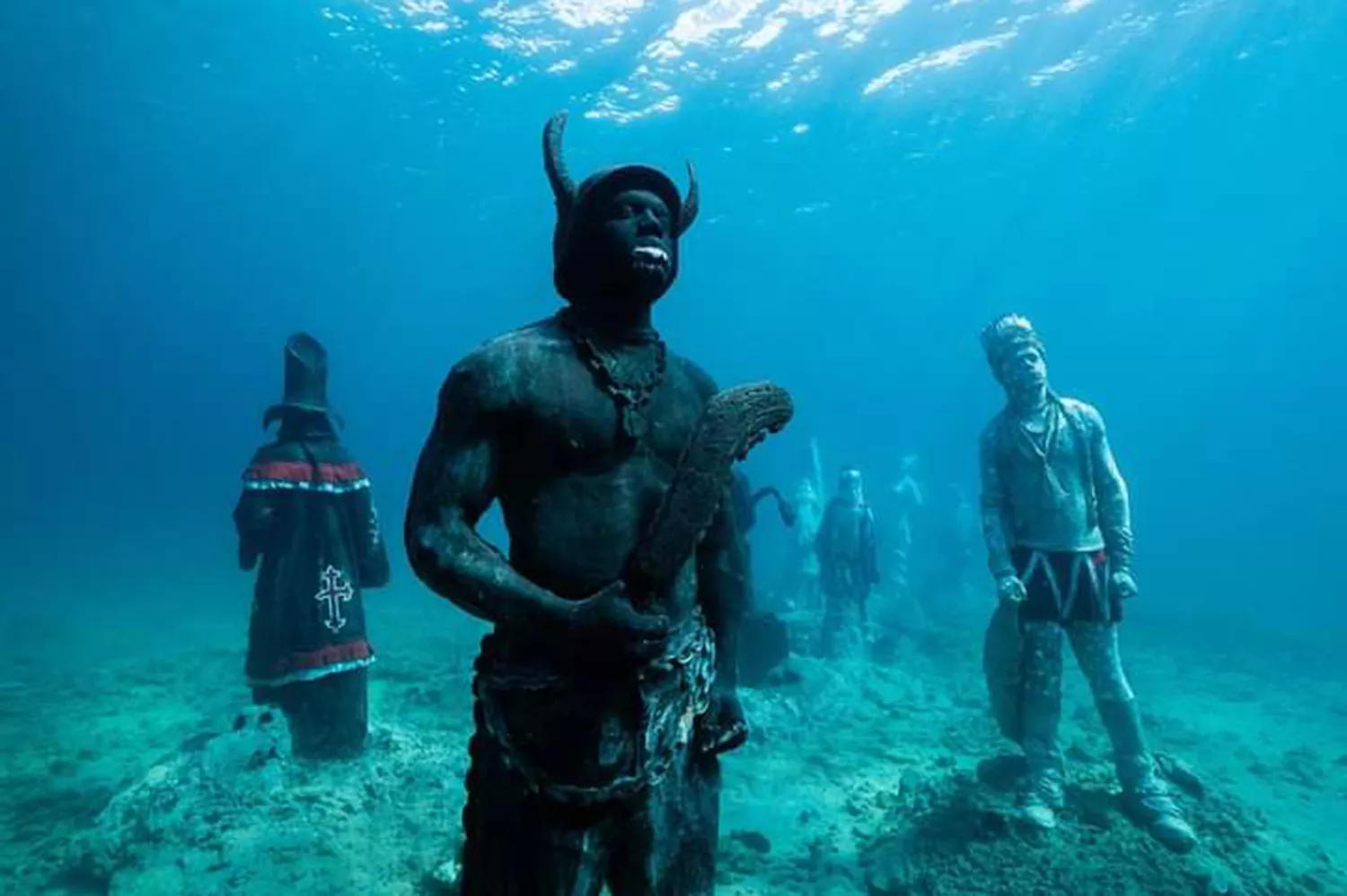As seen in Travel & Leisure
The newest additions to Molinere Underwater Sculpture Park pay tribute to Grenada’s history.

The sunlight fractures through warm, crystal-clear waters, illuminating the large stone sculpture of a female figure proudly holding a nutmeg above her crowned head. Fish dart all around me as I kick my fins and circle the sculpture, with flashes of color highlighting the magnificent portrait of local folklore. Her hair, although also made of stone, seems to dance and truly takes my breath away. (Well … it would if I wasn’t scuba diving.)
I’m in Grenada, also known as the “Isle of Spice,” exploring one of the world’s most spectacular eco-friendly art pieces. This beautiful statue of Grenada’s mythical Nutmeg Princess is part of the country’s Molinere Underwater Sculpture Park, which is the first of its kind in the Caribbean.
The underwater sculpture park has more than 75 works of art across 8,600 square feet of the Caribbean Sea floor. Designed by British artist Jason deCaires Taylor, they are constructed with mixtures of pH-neutral cement and stainless steel, an ideal composition for supporting underwater life. When first placed in the water 20 years ago, the statues served to regenerate the coral reef, following the massive destruction caused by 2004’s Hurricane Ivan.
These sculptures live five to eight feet below the surface, making them accessible to divers, snorkelers, and even glass bottom boats. The park also guides snorkelers and divers away from existing fragile reefs and thus earned a Marine Protected classification.
While praised internationally for this environmental sustainability, the sculpture park’s cultural significance is often overlooked. The Nutmeg Princess sculpture, for example, is the title character in the classic Grenadian folktale of an elusive princess who represents goodness and beauty in nature, teaching children about the importance of faith and friendship.

Nearby the princess is the sculpture of a man sitting at a desk with his typewriter surrounded by newspaper articles from the 1970s. It documents a time before Grenada’s 1979 revolution when the country became the only socialist state within the Commonwealth. Titled The Lost Correspondent, this statue highlights the rapidly changing state of communication, specifically surrounding this tumultuous time in history.
Perhaps the most celebrated work in the park is titled Vicissitudes, depicting a group of children standing in a ring, facing outward into the ocean as a symbol of unity and strength. Locally, they are also seen as a tribute to those lost throughout the slave trade due to the proximity to the harrowing Middle Passage, with the shackle-like metal that connects the children’s arms. They are beautiful and haunting.

Last year, 27 new pieces were added to the captivating collection. These statues, titled The Coral Carnival, are a collaboration between Taylor and local artists. Steeped in Grenada’s rich culture, these unique sculptures depict some of the most prominent characters in Grenada’s SpiceMas, an annual celebration of unity, pride, and emancipation from slavery.
“SpiceMas stands out because of its unique combination of tradition, innovation, and community spirit. Our carnival isn’t just about celebration; it’s deeply rooted in Grenada’s history,” Samantha Thomas, the marketing executive at Grenada Tourism Authority, told Travel + Leisure. “The Coral Carnival sculpture captures this essence beautifully. Just like SpiceMas, it is colorful, energetic, and alive with movement — only this time, the movement is underwater, where coral and marine life breathe life into the sculptures. It embodies the spirit of unity, celebration, and the natural rhythm that makes SpiceMas and Grenada so distinctive.”

One of the oldest personas of SpiceMas is Jab Jab, meaning “Double Devil” — a derogatory French term used by enslavers when referring to enslaved Africans. Today, the traditional Jab Jab costume is a satirical depiction of how enslavers treated the enslaved: masqueraders drape themselves in chains and horns, covering their bodies in motor oil or molasses.
Other SpiceMas characters include Shortknee, a colorful individual with bells around their ankles and a traveler who tells stories of their village; and Vieux Forts, typically seen wearing long colorful capes, tall, pointed hats, and wooden shoes. Both characters wear wire mesh masks symbolizing the loss of identity through slavery. They are all here, in the Molinère Underwater Sculpture Park, as a tribute to Grenada’s complex heritage.
These new, Coral Carnival sculptures are the only painted pieces in the underwater park. They are colorful, jeweled, and feathered, and radiating the vibrant spirit of masquerading dancers during Grenada’s Spice Mas. Their eyes peer forward through bright, blue waters from their place in the parade of Grenadian emancipation and prestige.
I glide through multiple versions of Jab Jab that line the Caribbean Sea floor, I spot an octopus slide into a small cave created at the base of a masquerader, and a brilliant blue anemone rolls up her leg. It is fascinating to watch life evolve on these powerful symbols of nationalism, history, and tenacity — a nod to the island’s ability to always care for her own. As I swim back to the boat, though, I can feel Grenada’s spirit of freedom, pride, and resilience reverberate through the water.

